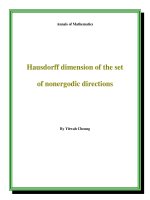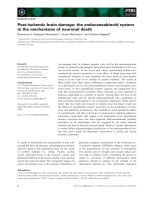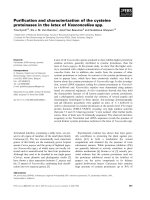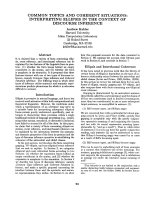The diversity of LTR retrotransposons ppt
Bạn đang xem bản rút gọn của tài liệu. Xem và tải ngay bản đầy đủ của tài liệu tại đây (107.21 KB, 6 trang )
Genome Biology 2004, 5:225
comment
reviews
reports deposited research
interactions
information
refereed research
Review
The diversity of LTR retrotransposons
Ericka R Havecker, Xiang Gao and Daniel F Voytas
Address: Department of Genetics, Development and Cell Biology, Iowa State University, Ames, IA 50011, USA.
Correspondence: Daniel F Voytas. E-mail:
Abstract
Eukaryotic genomes are full of long terminal repeat (LTR) retrotransposons. Although most LTR
retrotransposons have common structural features and encode similar genes, there is
nonetheless considerable diversity in their genomic organization, reflecting the different strategies
they use to proliferate within the genomes of their hosts.
Published: 18 May 2004
Genome Biology 2004, 5:225
The electronic version of this article is the complete one and can be
found online at />© 2004 BioMed Central Ltd
Transposons are mobile genetic elements that can multiply
in the genome using a variety of mechanisms. Retrotrans-
posons replicate through reverse transcription of their RNA
and integration of the resulting cDNA into another locus.
This mechanism of replication is shared with retroviruses,
with the difference that retrotransposons do not form infec-
tious particles that leave the cell to infect other cells. The
long terminal repeat (LTR) retrotransposons, one of the
main groups of retroelements (which include both LTR and
non-LTR retrotransposons as well as retroviruses), are
among the most abundant constituents of eukaryotic
genomes. The LTRs are the direct sequence repeats that
flank the internal coding region, which - in all autonomous
(functional) LTR retrotransposons - includes genes encoding
both structural and enzymatic proteins. The gag gene
encodes structural proteins that form the virus-like particle
(VLP), inside which reverse transcription takes place. The
pol gene encodes several enzymatic functions, including a
protease that cleaves the Pol polyprotein, a reverse transcrip-
tase (RT) that copies the retrotransposon’s RNA into cDNA,
and an integrase that integrates the cDNA into the genome.
Much of what we know about the mechanisms of LTR retro-
transposition (Figure 1) comes from work on yeast retro-
transposons [1,2], but it is generally assumed that the
mechanism is very similar among LTR retrotransposons
from divergent hosts. First, a retrotransposon’s RNA is tran-
scribed by the cellularly encoded RNA polymerase II from a
promoter located within the 5Ј LTR. The RNA is then trans-
lated in the cytoplasm to give the proteins that form the VLP
and carry out the reverse transcription and integration steps.
Typically, two RNA molecules are packaged into one virus-
like particle, and the RNA is subsequently made into a full-
length DNA copy through a reverse transcription reaction
that is first primed from a tRNA that pairs to a sequence
near the 5Ј LTR (the primer-binding site). The resulting
partial cDNA (called ‘strong stop’ DNA) is transferred from
the 5Ј LTR to the 3Ј LTR, where reverse transcription pro-
ceeds. A second priming event initiates at a polypurine tract
near the 3Ј LTR. The cDNA primed from the polypurine tract
undergoes an additional strand transfer, ultimately giving
rise to a double-stranded cDNA molecule. Finally, the cDNA
is integrated back into the host DNA, adding another copy of
the retrotransposon to the genome.
LTR retrotransposon diversity
As genome-sequence data has accumulated for a large
number of eukaryotes, it has become clear that the genomes
of most organisms contain LTR retrotransposons from multi-
ple distinct lineages. Although all are flanked by LTRs and
encode gag and pol genes, the lineages diverge considerably
in their DNA sequences and genomic organization. The Inter-
national Committee on Taxonomy of Viruses has attempted
to provide a taxonomic framework for understanding the
relationships among the vast numbers of retrotransposons
that have come to light through genome-sequence analysis
[3,4] (Figure 2); this framework is based on relationships
among the amino-acid sequences of the RT protein, the most
highly conserved of the retrotransposon proteins. Two retro-
transposon families - the Pseudoviridae and the Metaviridae
- have been described in detail; both are found in most
eukaryotes. The two families are also distinguished by the
order of the coding regions within their pol genes (see
Figure 3). Discovery of the Gmr1 retrotransposon from
Atlantic cod and related elements has shown that some
members of the Pseudoviridae (on the basis of RT sequence)
have a gene order characteristic of Metaviridae [5].
As with any taxonomic framework, the LTR retrotransposon
classification system undergoes frequent revision as diverse
elements are identified. This is particularly true for the
genera that make up the two main families. Three genera
have been proposed for the Pseudoviridae (Figure 2):
pseudoviruses, hemiviruses and sireviruses (whose names
do not necessarily indicate that they are viruses; Figure 2).
The sireviruses derive from plant hosts and make up a dis-
tinct lineage according to their RT amino-acid sequences;
the pseudoviruses and hemiviruses are distinguished by the
primer used for reverse transcription (a full tRNA or a half
tRNA, respectively). Note that this classification does not
correspond directly with the phylogenetic relationships of
the retrotransposons, so that the pseudoviruses make up
three distinct lineages (Figure 2). The Metaviridae also com-
prises three genera - the metaviruses, the errantiviruses and
the semotiviruses - which can be discriminated by phyloge-
netic analysis of RT amino-acid sequences. A distinct lineage
of elements, the DIRS group (named after the founding
member from Dictyostelium discoideum), has yet to be
placed within the taxonomic framework. In addition to
having characteristic RT sequences, the DIRS elements have
some unusual features: they lack a protease and have a tyro-
sine recombinase instead of an integrase [6,7].
Organization of the gag and the pol genes
Whereas RT amino-acid sequences and the order of domains
within pol are sufficiently conserved to be used to classify
the LTR retrotransposons, the ways in which gag and pol are
organized and expressed vary considerably. As multiple pro-
teins are encoded on one mRNA, the gag and pol genes in
some LTR retrotransposons are separated by a frameshift or
225.2 Genome Biology 2004, Volume 5, Issue 6, Article 225 Havecker et al. />Genome Biology 2004, 5:225
Figure 1
The life cycle of LTR retrotransposons. IN, integrase; PR, protease; RT, reverse transcriptase; VLP, virus-like particle. Black triangles represent the LTRs.
Nucleus
Cytoplasm
Chromosomes
mRNA
cDNA
Translation
VLP formation
and reverse
transcription
IN
RT
PR
GAG
AAAAAAAAA
AAAAAAAAA
A
A
A
A
A
A
A
A
A
IN
RT
Integration
PR
gag pol
IN
IN
IN
IN
g
a
g
p
o
l
Transcription
a stop codon, and occasionally these breaks in the reading
frame are ignored by the translational machinery. Much
more Gag than Pol is needed for productive VLP formation
and consequently for replication of the retrotransposon; the
use of either a stop codon that is occasionally ignored or
ribosomal frameshifting (strategies called recoding) are used
to regulate the ratio of the two proteins. We [8] have ana-
lyzed the genome sequences of Caenorhabditis elegans,
Schizosaccharomyces pombe, Drosophila melanogaster,
Candida albicans and Arabidopsis thaliana to predict the
strategies used to express their gag and the pol genes. By
analyzing the genomic structure and the nucleotide
sequences surrounding the gag-pol junction, the type of
recoding used for translation of the Pol protein could be
inferred [8]. The results indicated that the mechanism used
to express Pol is related to the host from which the retro-
transposon originates. For example, about 50% of the retro-
transposons identified in the study had a single open reading
frame (ORF) fusing Gag and Pol, and this organization was
the one found most often in plant elements. A single Gag-Pol
ORF does not undergo recoding per se but is subjected to
other mechanisms, such as differential protein degradation,
to ensure a high ratio of Gag to Pol. Retrotransposons in the
Metaviridae from the animal kingdom preferentially used -1
frameshifting to regulate Pol protein production. In contrast,
a +1 frameshift was more rarely observed but was distrib-
uted equally among kingdoms and among Pseudoviridae
and Metaviridae. Finally, stop-codon suppression was found
in a total of only two possible cases.
Additional open reading frames in LTR
retrotransposons
Although retrotransposon gag and pol genes are believed to
be necessary and sufficient for transposition, a number of
retrotransposon families with aberrant genomic organiza-
tions have now been identified (Figure 3). One frequent
structural change is the addition of coding information.
Retrotransposons with ‘env-like’ genes
One of the main differences between retrotransposons (with
a wholly intracellular life-cycle) and their infectious retro-
virus cousins is the presence of an envelope (env) gene in the
latter, which allows a virus particle to infect another cell. A
number of retroelements have an extra ORF in the same
position as the env gene found in retrovirus genomes
(Figure 3). The best characterized examples of env-contain-
ing retroelements are the Drosophila errantiviruses, includ-
ing gypsy and ZAM [9,10]. The life-cycle of these elements
has been examined in detail, and gypsy has been shown to
be infectious [11,12].
The presence of an env gene within a retroelement is not
limited to the errantiviruses; genomic studies have revealed
that env-like ORFs are widespread among retrotransposons
in both the Pseudoviridae (sireviruses) and Metaviridae
(errantiviruses, metaviruses and semotiviruses) [13,14]. Ele-
ments contaning an env-like ORF in each of these lineages
also originate from diverse host species. The retroelement
most recently shown to have an env-like ORF, Boudicca, is a
metavirus from a human blood fluke [15]. Other examples of
metaviruses include the Athila elements, which represent a
comment
reviews
reports deposited research
interactions
information
refereed research
Genome Biology 2004, Volume 5, Issue 6, Article 225 Havecker et al. 225.3
Genome Biology 2004, 5:225
Figure 2
A schematic tree and classification of LTR retrotransposons. The sectors
represent the diverse elements that make up each distinct lineage. The
DIRS lineage is named for the founding member from Dictyostelium
discoideum. Adapted from [3,4].
Pseudoviridae
Metaviridae
Unclassified DIRS group
Classification
Sirevirus
Pseudovirus
Hemivirus
Pseudovirus
Pseudovirus
DIRS
Metavirus
Errantivirus
Semotivirus
large proportion of the retroelements in Arabidopsis [16]. In
a related element in barley, Bagy-2, the env-like transcript is
spliced, similarly to the env transcripts of retroviruses [17].
Members of the sirevirus group make up half of the approxi-
mately 400 Pseudoviridae sequences present in GenBank,
and of these, about one third have an env-like ORF (X.G.
and D.V., unpublished observation). Semotiviruses (also
called BEL retrotransposons) with env-like ORFs have also
been described in nematode genomes as well as in pufferfish
and Drosophila [18,19].
Do Env-like proteins enable these diverse retroelements to
become infectious? In a few cases, the env-like genes have
been shown to be significantly similar in sequence to genes
of different viruses, suggesting that they were acquired by
retrotransposons through transduction of a cellular gene
[13]. Except for some errantiviruses, where the Env-like
protein has been implicated in infection, the function of the
Env-like proteins remains unclear. The amino-acid
sequences of these proteins are highly divergent, making it
difficult to assess whether or not they have a common func-
tion. That said, many Env-like proteins have predicted trans-
membrane domains (like retroviral Env proteins), although
this is not a universal feature. It is possible that retroviral
activity has evolved several times in the history of retrotrans-
posons, or that these genes may confer novel function(s),
such as movement between tissues of an organism (as sug-
gested for the gypsy elements) or movement within cells
(such as between the cytoplasm and the nucleus). Alterna-
tively, the Env-like proteins could serve as chaperone pro-
teins to facilitate replication. Functional studies are required
to discern the biological roles of these interesting genes.
Other additional ORFs
Other novel coding regions have also been identified within
various retrotransposons, but it is unclear how broadly these
coding sequences are conserved. For example, RIRE2 of rice
- a metavirus - has a small ORF of unknown function
225.4 Genome Biology 2004, Volume 5, Issue 6, Article 225 Havecker et al. />Genome Biology 2004, 5:225
Figure 3
The genomic organization of different types of LTR retrotransposon. Abbreviations: IN, integrase; LARDs, large retrotransposon derivatives; ORF, open
reading frame; PBS, primer-binding site; PPT, polypurine tract; PR, protease; RT, reverse transcriptase; TRIMs, terminal-repeat retrotransposons in
miniature. The upside-down text indicates that the ORF is transcribed in the antisense direction. See text for descriptions of each type of element.
Pseudovirus (Ty1/copia)
Metavirus (Ty3/gypsy)
Retrotransposons with
an env-like ORF
TRIMs
(such as Katydid)
LARDs
(such as Dasheng)
Retrotransposons with
non-coding or antisense
ORFs
gag
pol (PR-IN-RT)
PBS
PPT
PPTPBS
PPT
PBS
gag pol
ORF?
PPTPBS
gag pol env-like
PPTPBS
gag
pol (PR-RT-IN)
PPT
PBS
DNA not coding for proteinLong terminal repeat
Key
Open reading frame
Type Genomic Structure
upstream of its gag gene [20]. Some plant retrotransposons
carry ORF(s) that are antisense to the genomic RNA tran-
script (Figure 3), including the metaviruses RIRE2 of rice
and Grande1 of maize [21,22]. The functions of the antisense
ORFs are also unknown. In a few cases, retrotransposons
have acquired sequences that probably do not have any role
in the life cycle of the elements. The Bs1 retrotransposon of
maize, for example, has transduced a cellular gene sequence
- in this case a part of a gene encoding an ATPase [23,24].
LTR retrotransposons lacking ORFs
An intriguing story is emerging about the presence of non-
autonomous LTR retrotransposons in many eukaryotic
genomes. Non-autonomous elements do not encode the pro-
teins necessary for transposition; instead, they are mobilized
in trans by proteins provided from functional (autonomous)
elements. This mechanism is well documented for DNA
transposons [25], and recent genome-mining studies have
revealed many types of non-autonomous retrotransposons,
suggesting that the process also occurs among retrotrans-
posons. Typically, these elements lack all coding capacity but
have retained LTRs, a primer-binding site and a polypurine
tract (Figure 3). These are the minimal features required for
replication, because the LTRs contain the promoter needed
to produce a template RNA, and the primer-binding site and
the polypurine tract are needed to prime reverse transcrip-
tion. The success of some non-autonomous elements is stag-
gering; for example, the non-autonomous Dasheng and
Zeon-1 elements are each represented by around 1,000
copies in the maize genome [26,27].
For most non-autonomous retrotransposons, it is unclear
which autonomous element is involved in mobilization. Strik-
ing similarities between the non-autonomous Dasheng
element and the autonomous RIRE2 element, however, make
it very probable that RIRE2 provides the proteins needed to
move Dasheng [28]. The evidence for this, mostly provided
by the emerging rice genome sequence, includes a high
degree of sequence similarity within and adjacent to the LTRs
(suggesting that the promoters and/or sequences necessary
for reverse transcription are the same), a similar distribution
of RIRE2 and Dasheng along the rice chromosomes (suggest-
ing that they may be integrated by the same enzyme), the
presence of chimeric Dasheng/RIRE2 elements (suggesting
that RNAs from both elements are packaged within a single
virus-like particle), and the presence of young Dasheng and
RIRE2 elements (suggesting that these elements could be
co-expressed).
The non-autonomous Dasheng elements are large, ranging
in size from 5.5 kilobases (kb) to 8.5 kb [28]. Large non-
autonomous elements like Dasheng have now been named
‘large retrotransposon derivatives’ (LARDS) [29]. The
LARDs identified in barley and other members of the Trit-
iceae have LTRs of 4.5 kb and an internal domain of 3.5 kb.
The internal domain of the LARDs contains conserved non-
coding DNA that may provide important secondary structure
to the mRNA, although it is not known how these non-
coding sequence features function in the life cycle of the
LARDs. On the basis of sequence identity, it seems that
barley LARDs may be mobilized by a retrotransposon
related to the metaviruses Erika-1 of the wheat Triticum
monococcum and RIRE3 of rice.
Finally, a second class of non-autonomous LTR retrotrans-
posons has been identified in plants, called ‘terminal-repeat
retrotransposons in miniature’ (TRIMs; Figure 3). They
were originally identified in a potato urease gene intron and
subsequently found in the Arabidopsis genome, where the
founding element was named Katydid [30]. TRIMs also lack
an internal coding domain but, in contrast to the LARD type
of non-autonomous retrotransposon, TRIMs are very small -
less than 540 bp overall. There are TRIMs in both mono-
cotyledonous and dicotyledonous plants, but no autonomous
partner has been found or proposed. The location of TRIMs
within promoters and introns indicates that these elements
have been important in restructuring plant genomes.
Non-coding information in LTR
retrotransposons
Variation in retrotransposon genomic organization is not
limited to the presence or absence of coding information.
Some retrotransposons contain a large amount of conserved
non-coding sequence. The barley LARD element with 3.5 kb
of non-coding DNA (mentioned above) is one example;
another is a group of plant metaviruses that carry several
kilobases of non-coding DNA between pol and the 3Ј LTR.
Among these are the maize Cinful [31] and Grande1 [22] ele-
ments, RIRE2 from rice [21] and Tat1 from Arabidopsis
[32]. For Grande1 and RIRE2, antisense ORFs have been
described, but they do not account for the entire segment of
non-coding DNA [21,22]. In addition, many retrotrans-
posons, including the Grande1 and Cinful elements, have a
series of short tandem repeats very close to the 3Ј end of the
pol gene, or at a putative pol-env junction. This may suggest
a potential function for the tandem repeats: they may facili-
tate recombination and acquisition of new coding informa-
tion through gene transduction [31]. In support of this
hypothesis, repeated non-coding information seems to be
found between the env-like ORF and the 3Ј LTR in both the
SIRE1 [33] and Athila retrotransposons [16]. In the retro-
transposons with env-like ORFs, the repeats show similarity
to polypurine tracts, suggesting that they might instead have
a role in reverse transcription.
The sequenced eukaryotic genomes have provided a new
appreciation of the diversity among LTR retrotransposons.
As sequence data accumulate, additional novel elements are
likely to be revealed. The challenge in the future will be
to understand how diversity in retrotransposon genome
comment
reviews
reports deposited research
interactions
information
refereed research
Genome Biology 2004, Volume 5, Issue 6, Article 225 Havecker et al. 225.5
Genome Biology 2004, 5:225
organization and coding sequences reflects differences in
retrotransposition mechanisms and strategies employed by
these elements to colonize their host genomes.
References
1. Voytas DF, Boeke JD: Ty1 and Ty5 of Saccharomyces cerevisiae.
In Mobile DNA II. Edited by Craig NL, Craigie R, Gellert M, Lam-
bowitz AL. Washington, DC: ASM Press; 2002:631-662.
2. Sandmeyer SB, Aye M, Menees T: Ty3, a position-specific, gypsy-
like element in Saccharomyces cerevisiae. In Mobile DNA II.
Edited by Craig NL, Craigie R, Gellert M, Lambowitz AL. Washing-
ton, DC: ASM Press; 2002:663-683.
3. Boeke JD, Eickbush T, Sandmeyer SB, Voytas DF: Pseudoviridae. In
Virus Taxonomy: Eighth Report of the International Committee on Taxon-
omy of Viruses. Edited by Fauquet CM. New York: Academic Press;
2004: in press.
4. Boeke JD, Eickbush T, Sandmeyer SB, Voytas DF: Metaviridae. In
Virus Taxonomy: Eighth Report of the International Committee on Taxon-
omy of Viruses. Edited by Fauquet CM. New York: Academic Press;
2004: in press.
5. Goodwin TJ, Poulter RT: A group of deuterostome Ty3/gypsy-
like retrotransposons with Ty1/copia-like pol-domain
orders. Mol Genet Genomics 2002, 267:481-491.
6. Goodwin TJ, Poulter RT: The DIRS1 group of retrotrans-
posons. Mol Biol Evol 2001, 18:2067-2082.
7. Goodwin TJ, Poulter RT: A new group of tyrosine recombi-
nase-encoding retrotransposons. Mol Biol Evol 2004, 21:746-759.
8. Gao X, Havecker ER, Baranov PV, Atkins JF, Voytas DF: Transla-
tional recoding signals between gag and pol in diverse LTR
retrotransposons. RNA 2003, 9:1422-1430.
9. Pelisson A, Mejlumian L, Terzian C, Bucheton A: Drosophila
germline invasion by the endogenous retrovirus gypsy:
involvement of the viral env gene. Insect Biochem Mol Biol 2002,
32:1249-1256.
10. Leblanc P, Desset S, Giorgi F, Taddei AR, Fausto AM, Mazzini M,
Dastugue B, Vaury C: Life cycle of an endogenous retrovirus,
ZAM, in Drosophila melanogaster. J Virol 2000, 74:10658-10669.
11. Song SU, Gerasimova T, Kurkulos M, Boeke JD, Corces VG: An
env-like protein encoded by a Drosophila retroelement: evi-
dence that gypsy is an infectious retrovirus. Genes Dev 1994,
8:2046-2057.
12. Kim A, Terzian C, Santamaria P, Pelisson A, Prud’homme N, Bucheton
A: Retroviruses in invertebrates: the gypsy retrotransposon is
apparently an infectious retrovirus of Drosophila
melanogaster. Proc Natl Acad Sci USA 1994, 91:1285-1289.
13. Malik HS, Henikoff S, Eickbush TH: Poised for contagion: evolu-
tionary origins of the infectious abilities of invertebrate
retroviruses. Genome Res 2000, 10:1307-1318.
14. Eickbush TH, Malik HS: Origins and evolution of retrotrans-
posons. In: Mobile DNA II. Edited by Craig NL, Craigie R, Gellert M,
Lambowitz AL. Washington, DC: ASM Press; 2002:1111-1144.
15. Copeland CS, Brindley PJ, Heyers O, Michael SF, Johnston DA,
Williams DL, Ivens AC, Kalinna BH: Boudicca, a retrovirus-like
long terminal repeat retrotransposon from the genome of
the human blood fluke Schistosoma mansoni. J Virol 2003,
77:6153-6166.
16. Wright DA, Voytas DF: Athila4 of Arabidopsis and Calypso of
soybean define a lineage of endogenous plant retroviruses.
Genome Res 2002, 12:122-131.
17. Vicient CM, Kalendar R, Schulman AH: Envelope-class retro-
virus-like elements are widespread, transcribed and spliced,
and insertionally polymorphic in plants. Genome Res 2001,
11:2041-2049.
18. Bowen NJ, McDonald JF: Genomic analysis of Caenorhabditis
elegans reveals ancient families of retroviral-like elements.
Genome Res 1999, 9:924-935.
19. Frame IG, Cutfield JF, Poulter RTM: New BEL-like LTR retro-
transposons in Fugu rubripes, Caenorhabditis elegans, and
Drosophila melanogaster. Gene 2001, 263:219-230.
20. Kumekawa N, Ohtsubo H, Horiuchi T, Ohtsubo E: Identification
and characterization of novel retrotransposons of the gypsy
type in rice. Mol Gen Genet 1999, 260:593-602.
21. Ohtsubo H, Kumekawa N, Ohtsubo E: RIRE2, a novel gypsy-type
retrotransposon from rice. Genes Genet Syst 1999, 74:83-91.
22. Martinez-Izquierdo JA, Garcia-Martinez J, Vicient CM: What makes
Grande1 retrotransposon different? Genetica 1997, 100:15-28.
23. Bureau TE, White SE, Wessler SR: Transduction of a cellular
gene by a plant retroelement. Cell 1994, 77:479-480.
24. Jin YK, Bennetzen JL: Integration and nonrandom mutation of
a plasma membrane proton ATPase gene fragment within
the Bs1 retroelement of maize. Plant Cell 1994, 6:1177-1186.
25. Feschotte C, Jiang N, Wessler SR: Plant transposable elements:
where genetics meets genomics. Nat Rev Genet 2002, 3:329-341.
26. Jiang N, Bao Z, Temnykh S, Cheng Z, Jiang J, Wing RA, McCouch SR,
Wessler SR: Dasheng: a recently amplified nonautonomous
long terminal repeat element that is a major component of
pericentromeric regions in rice. Genetics 2002, 161:1293-1305.
27. Hu W, Das OP, Messing J: Zeon-1, a member of a new maize
retrotransposon family. Mol Gen Genet 1995, 248:471-480.
28. Jiang N, Jordan IK, Wessler SR: Dasheng and RIRE2. A non-
autonomous long terminal repeat element and its putative
autonomous partner in the rice genome. Plant Physiol 2002,
130:1697-1705.
29. Kalendar R, Vicient CM, Peleg O, Anamthawat-Jonsson K, Bolshoy A,
Schulman AH: Large retrotransposon derivatives: abundant,
conserved, but nonautonomous retroelements of barley
and related genomes. Genetics 2004, 166:1437-1450.
30. Witte CP, Le QH, Bureau T, Kumar A: Terminal-repeat retro-
transposons in miniature (TRIM) are involved in restructur-
ing plant genomes. Proc Natl Acad Sci USA 2001, 98:13778-13783.
31. Sanz-Alferez S, SanMiguel P, Jin YK, Springer PS, Bennetzen JL:
Structure and evolution of the cinful retrotransposon family
of maize. Genome 2003, 46:745-752.
32. Wright DA, Voytas DF: Potential retroviruses in plants: Tat1 is
related to a group of Arabidopsis thaliana Ty3/gypsy retro-
transposons that encode envelope-like proteins. Genetics
1998, 149:703-715.
33. Laten HM, Havecker ER, Farmer LM, Voytas DF: SIRE1, an
endogenous retrovirus family from Glycine max, is highly
homogeneous and evolutionarily young. Mol Biol Evol 2003,
20:1222-1230.
225.6 Genome Biology 2004, Volume 5, Issue 6, Article 225 Havecker et al. />Genome Biology 2004, 5:225









